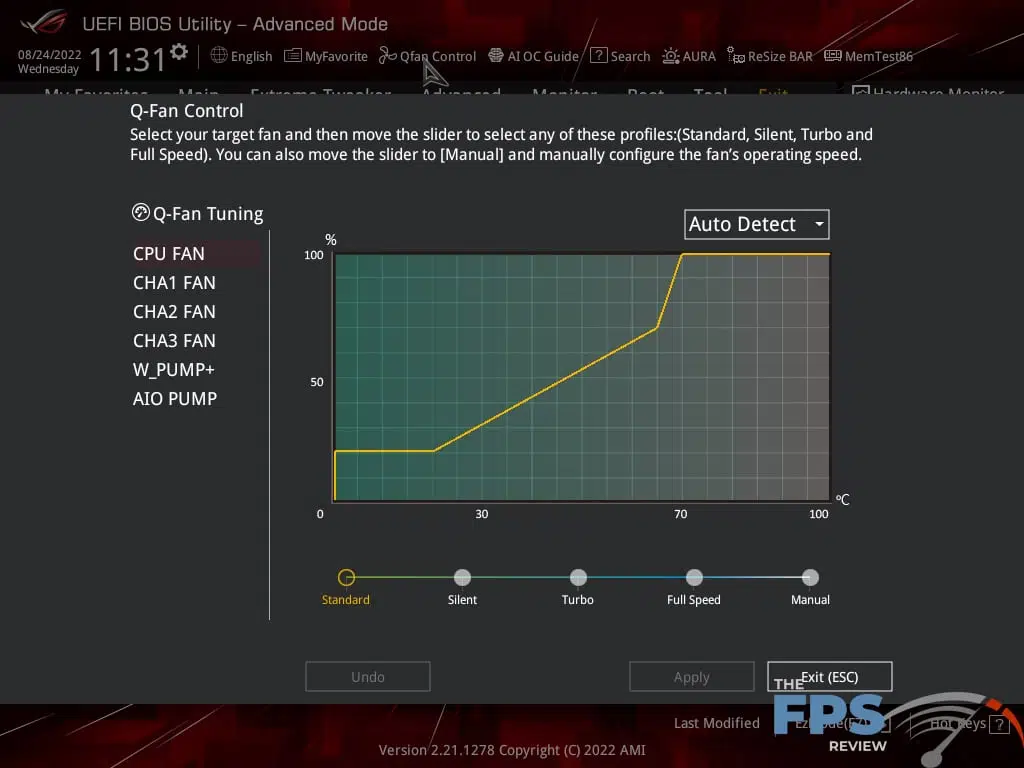BIOS
The ASUS ROG MAXIMUS Z690 APEX features dual 256Mb American Megatrends Inc. UEFI BIOS ROMs. It supports WOL, PME, and PXE management functions.
The UEFI BIOS itself is virtually identical to that of every other ASUS board released in the ROG line for the last several years. Obviously, it changes based on some specific motherboard features, and the platform, chipset, and CPU all necessitate some other minor changes. However, if you’ve ever used ASUS’ UEFI before you’ll feel at home here.





ASUS UEFI implementation is largely the same as its ever been for a very good reason. In my opinion, ASUS’ UEFI is the best in the industry. No, I’m not talking about in terms of being bug-free or anything along those lines. But rather in terms of the user experience, it offers which really is second to none. There are a few others that are similarly good, but many of those are clones of ASUS’ UEFI. Of course, this is a subjective matter, but I have used every major UEFI implementation out there since the Z68 days and while other good ones have come and gone, ASUS has had to iterate the least because the company nailed it out of the gate.





The main thing I appreciate beyond its fantastic organization are things like consistent tooltips letting you know what each setting does. The implementation also offers the ability to manipulate values by keying them in manually a lot of times or using the enter key, mouse, drop-down selection, etc. for just about every setting consistently. Target and current values are displayed for a lot of things, and ASUS avoids the trap of placing settings six submenus deep for the sake of organization. A design decision that rarely works all that well in my opinion.
The UEFI offers all the features you would expect from an ultra-high-end overclocking motherboard. Because we are dealing with a high-end VRM implementation, you often end up with a great deal of granular adjustment capability for any given setting. Increments for values are small and if you are headed into unsafe territory the color will change to let you know if you are in the yellow or red with those values. ASUS also always displays a hardware monitor on the right-hand side but offers a more detailed and dedicated hardware monitor which offers a great deal more information.





ASUS’ UEFI offers plenty of wizards to allow easy use of some more advanced features. Additionally, it always shows hardware monitoring on the right side. One difference between the ROG lineup and the standard motherboards is that ROG motherboards default to the advanced mode rather than the EZ Mode.
As is the case with most motherboards these days, the ASUS ROG MAXIMUS Z690 APEX does offer an EZ Mode. This is essentially a single status screen that shows the most pertinent information as well as provides access to basic configuration options and the wizards to do some of the more advanced tasks. There is even an overclocking guide of sorts built into the menus.





ASUS’ Extreme Tweaker menu gives you all of the types of options you need for tuning memory and CPU. Frankly, there are a lot of options you would never use unless you are trying to push extreme overclocking with LN2 or some type of sub-ambient cooling. As you can see from the screenshots, there are tons of sub-menus and settings for tuning. Far more than is generally necessary, but enough to ensure you can get the most from your CPU. This includes things like per core overclocking for P-Core and E-Cores,





In the advanced mode, ASUS has some unique offerings including their “My Favorites” menu. This allows you to create shortcuts to settings in a custom menu of sorts. ASUS’ fan controls are also rather unique in that they don’t have the line graph and plot points that most UEFI fan controls do. Instead, ASUS uses simple drop-down menus to make things work. You can set each fan via profiles or configure them manually.
This control extends to all of the fan headers on the board. You also have fan step-up and down controls which is a nice touch. A lot of boards do not offer that. There is a wizard for Q-Fan control that offers a more conventional fan control experience that’s a lot more like what you would get on competing motherboard brands.









There are other tools such as a built-in version of MemTest86 and a secure SSD erase utility. You also get a BIOS flash tool built-in, although that’s not unusual these days. Of course, with a high-end board like the ASUS ROG MAXIMUS Z690 APEX, a lot of the features offered in the hardware have specific settings available in UEFI such as controls for the Hydranode, BIOS Image rollback support, ASUS’ Flexkey, user profiles, SPD information reader, etc.
My main complaint is that ASUS does not offer any real RGB controls within the UEFI itself. Some models have offered a little of this in the past, but the ASUS ROG MAXIMUS Z690 APEX only really offers the ability to turn RGB off or on and to control whether or not any of the lighting works when the system is powered off.
